And all along you all though that caring for a bonsai tree took up all your time, sitting in the garden, babying and doting over it, drinking green tea and eating sushi. It’s not really like that. Mostly you’re just watering. To be honest, the second most common reason a tree declines and dies (behind watering mistakes) is babying it, subjecting your tree to too much work and over-pruning. Sometimes it’s best just to let it grow and ignore the tree for a while. And drink beer instead of green tea.
Now, I’m not saying to forget to water it or something boneheaded like that, especially in the summer, but letting a bonsai grow and letting it get out of shape gives the tree a chance to gain energy. And it makes for a spectacular “before and after” when one writes a bonsai blog, that’s what all the professionals do.
Here’s a neglected ilex for you (a dwarf yaupon holly, or ilex vomitoria “schillings” for those so inclined) 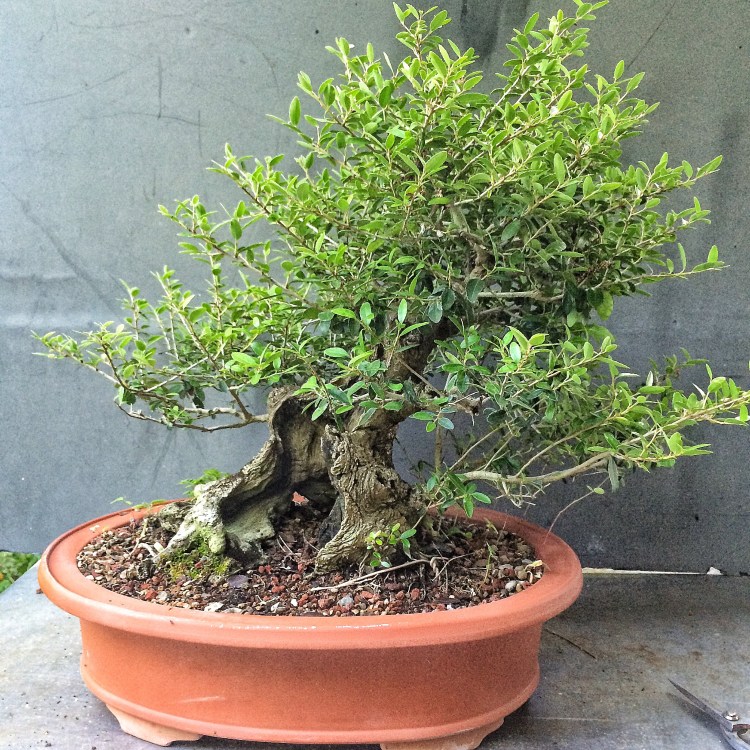 It’s been in the blog before so this is kinda an update I guess. I can’t find the first post, sorry. Whoever finds it first I’ll figure out a prize for them.
It’s been in the blog before so this is kinda an update I guess. I can’t find the first post, sorry. Whoever finds it first I’ll figure out a prize for them.
Since you’ve seen it last, though, I’ve removed the initial wiring and done a few trimmings. But I haven’t touched it for at least three seasons (fall-spring). It is now just about summer (damn it’s hot already, here in Orlando, I was seeing on Facebook that they just had 38 degree Fahrenheit weather up in the Ohio area, weird).
Your eyes are not deceiving you, the trunk is totally hollow. 
I can just about fit my whole fist up inside.  But in some states, it’s against the law to show those type of images, and since I am a traveling bonsai teacher and I don’t wish to spend any time in jail on one of my tours, I won’t.
But in some states, it’s against the law to show those type of images, and since I am a traveling bonsai teacher and I don’t wish to spend any time in jail on one of my tours, I won’t.
Now, it’s a given that I’m going to cut back the bush… 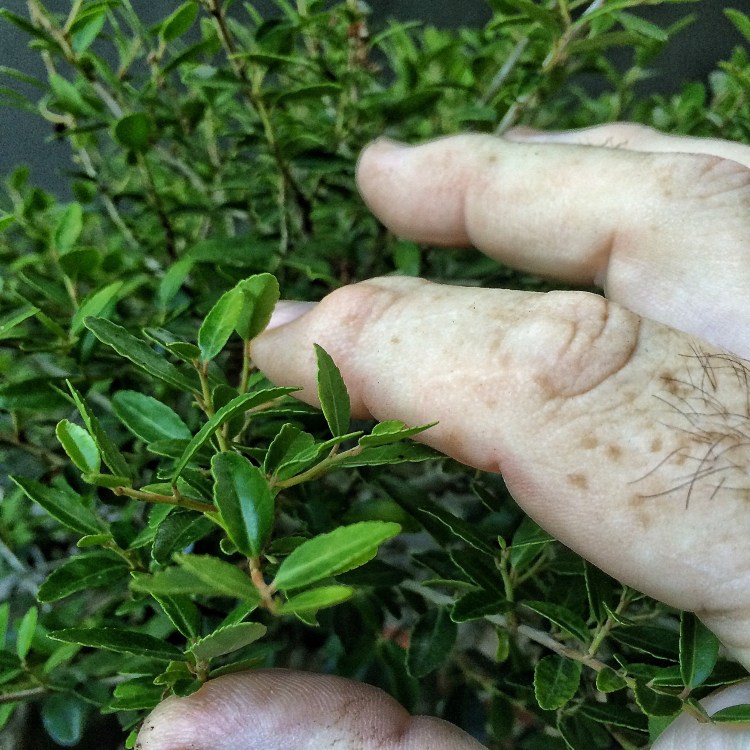
 ….but I’m also going to show you how to address the soil if you might have forgotten to have repotted this year (you say “Hey! Soil, are you ready…..” Sorry, I stole that one from Bill, who you might remember, gave us the theme for the last post). Or you weren’t able to repot because maybe you were in the hospital, or in jail or something.
….but I’m also going to show you how to address the soil if you might have forgotten to have repotted this year (you say “Hey! Soil, are you ready…..” Sorry, I stole that one from Bill, who you might remember, gave us the theme for the last post). Or you weren’t able to repot because maybe you were in the hospital, or in jail or something.
Speaking of jail, the Bonsai Police will be after me for the first branch:  The list of crimes-
The list of crimes-
1) it’s too low
2) it’s too thin to be a number one branch.
But we must remember, even though this is Art, it’s also Horticulture; if I remove it, I could lose the whole side of the tree, and we don’t want that to happen. And so it stays.
So there! Catch me if you can Bonsai Police.
A little off the top, close on the sides….  That’s a joke but, in all actuality, cutting the side branches back harder than the top, with some trees, is how you should prune them. Not the yaupon per se but let’s propose we have an azalea. Some trees are apically dominant, like a spruce or a pine, or a deciduous tree. That means that the tree wants to push all its growth to the apex, picture a Christmas tree: all pointy on top. With an azalea (and most bushes) the plant’s growth is more horizontal, it wants to create many side stems as opposed to that single, strong leader. This makes it tough to grow as a bonsai. So when pruning, you cut the sides back harder than the top. But that’s another post on another blog.
That’s a joke but, in all actuality, cutting the side branches back harder than the top, with some trees, is how you should prune them. Not the yaupon per se but let’s propose we have an azalea. Some trees are apically dominant, like a spruce or a pine, or a deciduous tree. That means that the tree wants to push all its growth to the apex, picture a Christmas tree: all pointy on top. With an azalea (and most bushes) the plant’s growth is more horizontal, it wants to create many side stems as opposed to that single, strong leader. This makes it tough to grow as a bonsai. So when pruning, you cut the sides back harder than the top. But that’s another post on another blog.
Time for some wire.  Let’s conduct a few polls: with aluminum wire, do you prefer the classic brown anodization or the new black? And, would you entertain wire with the natural aluminum color (greyish)? For copper, do you prefer the shiny new copper look (which means an electrical current was run through it to heat it up in order to anneal or soften it) or do you prefer the kiln fired annealing process, which gives it a mottled and almost purple appearance? Let me know. Myself, I’m leaning towards a nice pink on the aluminum. It’d be purty.
Let’s conduct a few polls: with aluminum wire, do you prefer the classic brown anodization or the new black? And, would you entertain wire with the natural aluminum color (greyish)? For copper, do you prefer the shiny new copper look (which means an electrical current was run through it to heat it up in order to anneal or soften it) or do you prefer the kiln fired annealing process, which gives it a mottled and almost purple appearance? Let me know. Myself, I’m leaning towards a nice pink on the aluminum. It’d be purty.
While your thinking of that, let me finish the wiring. 
The tree didn’t get repotted this year (it’s too late to do it now) and summer is coming. In Florida that means 90f degree plus temps but with rainstorms that could dump more than 3 inches of rain at one time. The ilex puts out copious fine feeder roots that clog the potting mix and that makes it a priority to repot often. 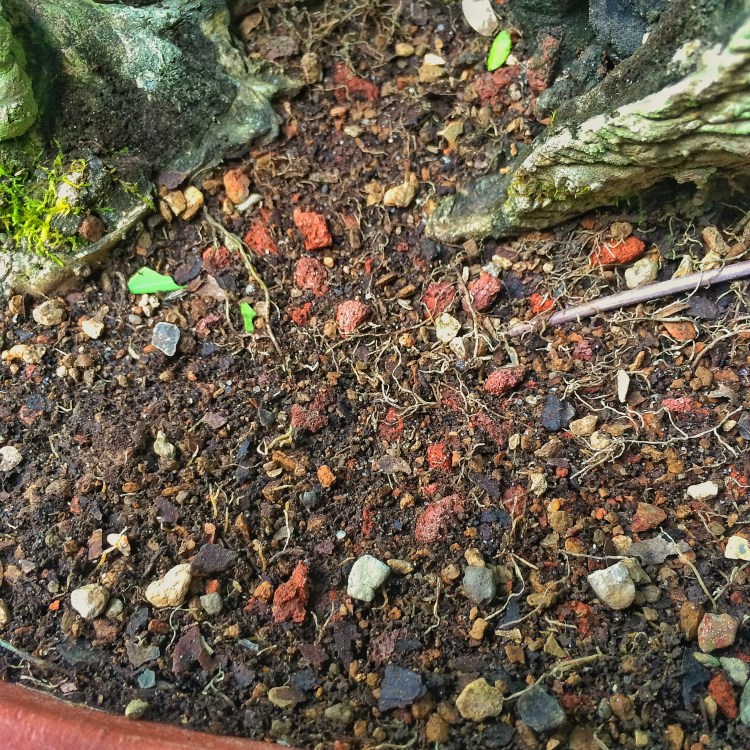 Combine that with the leftover organic fertilizer (I don’t use cakes or pellets or tea bags. I apply it right on the soil. My practice and my prerogative) and it means that this tree will stay too wet at times but will dry up fast if we have a dry day. Oh, woe is me, what’s a bonsai person to do?!
Combine that with the leftover organic fertilizer (I don’t use cakes or pellets or tea bags. I apply it right on the soil. My practice and my prerogative) and it means that this tree will stay too wet at times but will dry up fast if we have a dry day. Oh, woe is me, what’s a bonsai person to do?!
Address the soil (or, more precisely, redress the soil).
Using a chopstick, or some similar pointy thingy, rough up the top half inch or so of soil (this won’t hurt the roots much, think of all the damage done to the roots on the soil surface in the wild by falling branches, small woodland creatures, smurfs, and the ever growing cast of survival show people, compared to that, a little chopsticking is minor) 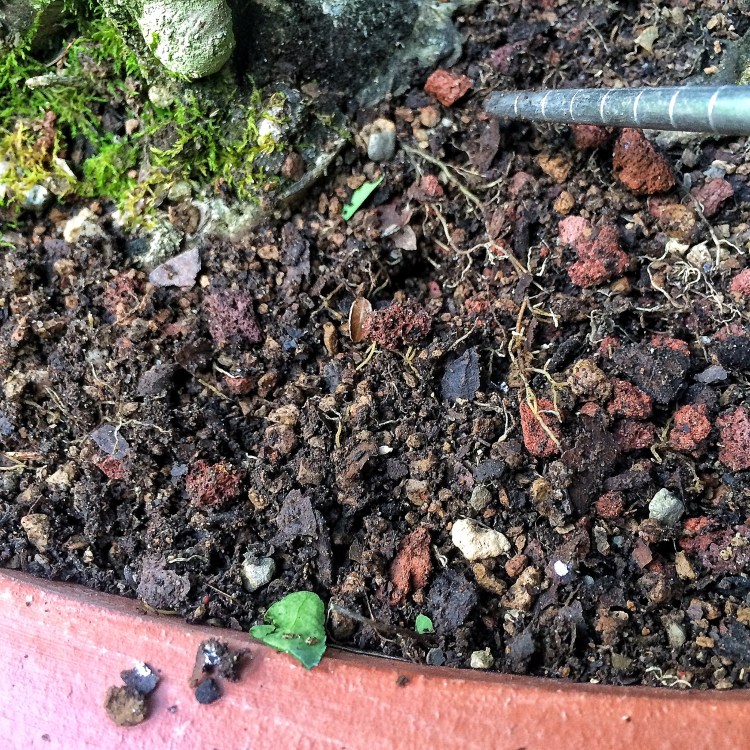 Then dump all that crap out. (Literally in this case, the fertilizer I use is derived from what the scientists call “poo”).
Then dump all that crap out. (Literally in this case, the fertilizer I use is derived from what the scientists call “poo”).  Then, returning to the chopstick, poke some holes in the soil all the way down to the pot’s bottom. Maybe one hole every inch or so. Put some fresh fertilizer down.
Then, returning to the chopstick, poke some holes in the soil all the way down to the pot’s bottom. Maybe one hole every inch or so. Put some fresh fertilizer down.  An backfill the top with new soil.
An backfill the top with new soil. 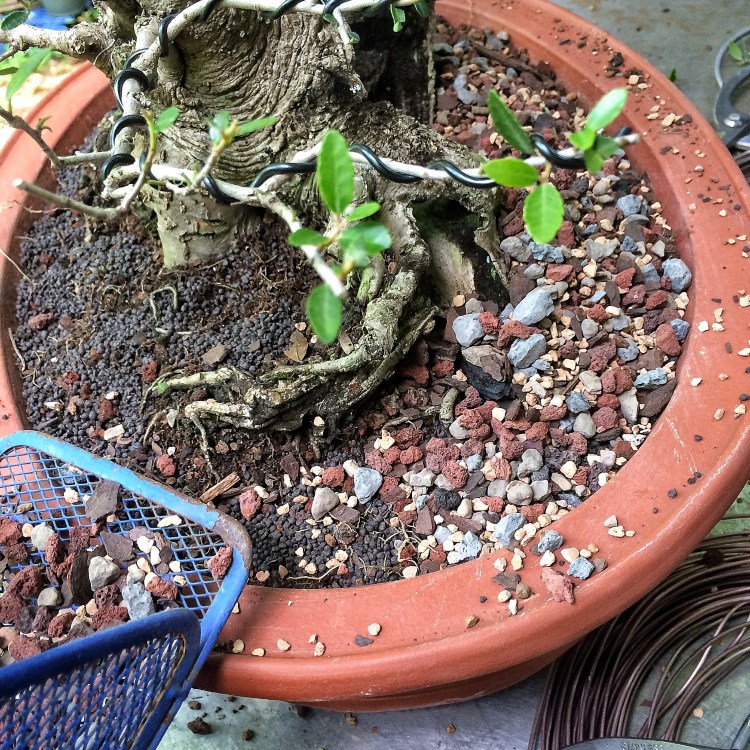 And mix the whole mess in well.
And mix the whole mess in well.
Ah, look! Some charcoal.  Horticultural charcoal to be precise.
Horticultural charcoal to be precise.
Let’s see how much trouble I can get into dissecting the characteristics and usage of charcoal in a soil mix.
Charcoal is usually made of wood, combusted in a limited atmosphere. It could also be bone or other animal/vegetable matter. Do not confuse charcoal with charcoal briquettes, those chopped and formed stars of backyard barbecues all over the country. They have bonding agents and most have lighter fluid impregnated in them to make them easier to light on fire. It’s safe to say, we do not use charcoal briquettes in horticultural applications.
There’s also this stuff called agrichar and many people use charcoal and agrichar synonymously. And they are close in makeup and use, but the agrichar group distinguishes the two harshly (Aha! There’s the rub. You see, agrichar is a politically charged subject. When you research it, therefore, everything you read about it must be read with a grain of salt). The biggest difference is that agrichar must be sourced from strictly vegetable matter, must be from waste products, and must be sustainable. Which is funny, because it evolved from this thing called terra preta, an Amazonian type of soil that has clay pottery shards and charcoal amendments that itself, evolved from the much derided slash and burn method of nourishing the poor Amazon soil that is partly being blamed for the deforestation of the South American Rainforest. I won’t go into detail about either agrichar or terra preta but I suggest you look into it further, it’s an interesting read. Just remember that grain of salt. There are agendas being pushed. Speaking of which……
There are agendas (and reputations, commercial interests, and even entrenched traditions) in the use of charcoal in bonsai soil. Therefore, the research I did was purposefully not done in the bonsai world. Why? This is a bonsai blog, ain’t it? Well, for some reason, most “evidence” presented in the bonsai world is anecdotal. Which means that _________, who’s been doing bonsai for thirty years, has great success using _________and he must be right but then that new Japanese apprentice dude from_____just said that using __________is wrong because he just finished his Japanese apprenticeship and his Master says that we should never use _________.
Let’s go to the science, shall we?
Basically, charcoal is an organic additive to the mix that serves the same purpose of, say pine bark or fir bark. But it doesn’t break down as fast. That purpose is to provide a high C.E.C. component that holds nutrients and releases them to your tree when it needs it and provide an environment for the various microorganisms necessary for a healthy soil. Charcoal’s structure is better than bark because the hard chunkiness of it won’t compact like bark could. It’s drawback is that it will change the ph to a more alkaline state, so acid loving plants (most flowering/fruiting varieties) may not appreciate an addition of charcoal.
It does not purify the water you apply to your trees, unless you are using nothing but charcoal and it’s an “activated” form (I won’t get into that, other than to say that horticultural charcoal is not activated).
It does not filter out excess synthetic fertilizer salts, no charcoal does. Period.
Some people say it deodorizes soil. It could but I don’t think there’s enough in the mix.
It does “sweeten” the soil, which means to make it more alkaline, which I covered already.
It makes your trees smell like a good, slow smokin’ barbecue joint. Always a plus. Hmmmmmm….
It is a good amendment to bonsai soil, but not for the reasons usually stated. And with that, I’m thinking I’m done talking about charcoal. If you are foaming at the mouth at this point, feel free to criticize, please don’t cite anecdotal evidence when trying to eviscerate me though. Thanks, I appreciate it.
Anyway, back to the tree….. since I’ve finished it while I’ve been boring you with all my scientifical declaratory sentences.
And the after:  I really need a different pot but the tree is looking good. Let’s crop the pot out.
I really need a different pot but the tree is looking good. Let’s crop the pot out. 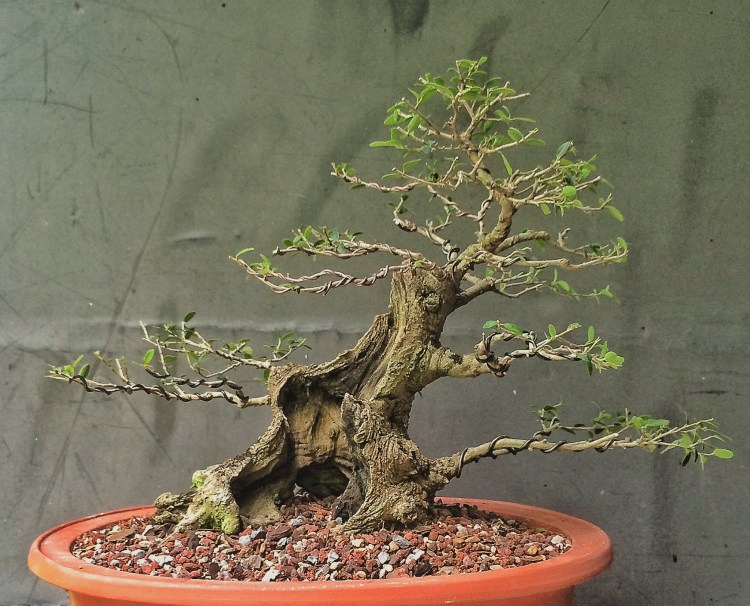 You know, I’m not really sure what type of pot the tree would look best in.
You know, I’m not really sure what type of pot the tree would look best in.
Oh well, that’s a puzzle to be worked out next potting season. With that, when eating your charcoal for that detoxifying effect that they talk about on Facebook, make sure you chew it thoroughly and drink lots of water. And brush your teeth, black is not your color.
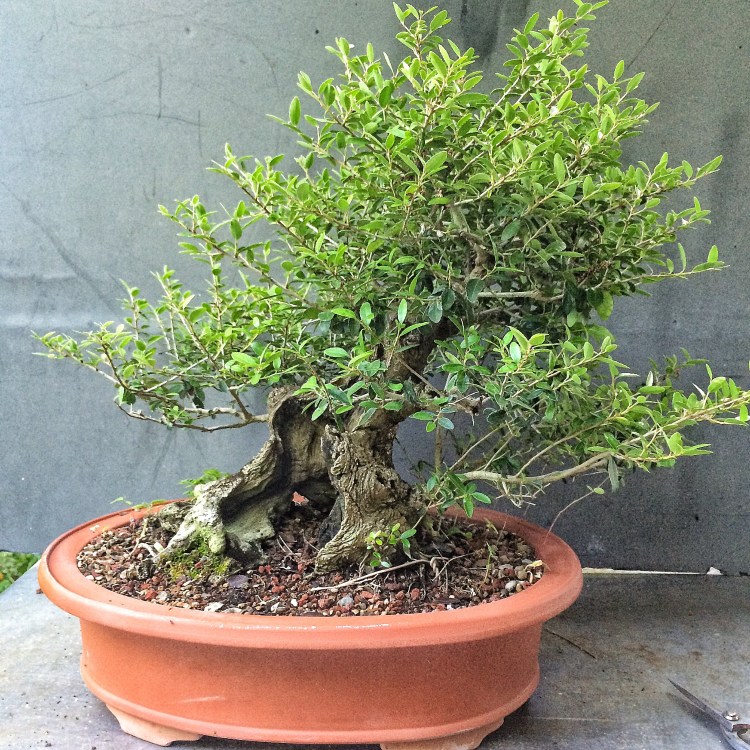
Useful information as usual…thank you. Have you ever used a shop vac to do a partial soil replacement? I tried it on my Bougie and it worked great accomplishing similar results without a chop stick. Nice tree BTW…when do you start working on the twigging since it appears the canopy is complete?
LikeLike
The twigging is happening already Phil, since I did the work there are bright red buds all over it now. If I had a good pot I could show it
LikeLike
I was always hesitant to believe any of the magic powers that charcoal has as a soil additive. Science prevails again!
LikeLike
Hi Adam, I really enjoy your blog. I am in the process of trying to style a couple of Dwarf Yaupon Holly. I got the plants (big bushes then) from a friend that was putting in a pool. So basically I chopped them down and now has new growth. It has lots of trunks and at this point do not know what to do next..HELP. Did you hollow the truck
LikeLike
Hi Liz,
I did not hollow the trunk except to clean out the rotten wood.
To help you, especially with a lot of branches, I’d need to see the tree. Are you in Florida?
LikeLike
Hi Adam, Nope I am in Central Texas. Can I upload some pics?
LikeLike
It won’t let you here. Send them to adamaskwhy at yahoo.com
LikeLike
Hi Adam, I read your blog and have posted here before. I live in Puerto Rico and came across a Fukien Tea which I now own. Do you think it can survive outside? Apparently it wa skept outside before, but I’m not so sure. What do you think?
LikeLike
In Puerto Rico it will definitely survive. I grow them here in Orlando. Be careful that you move it slowly into the sun so you don’t sunburn it and water daily. They like a lot of water
LikeLike
Alright, thanks!
LikeLike
Also, another question (I’m so so sorry). For someone with relatively little experience in bonsai, would you suggest a Nia (saltwood) or a Ficus? I’ve seen your posts on Nias and being in Puerto Rico, I can get my hands on one relatively easily. Would they be better for a beginner or should I just go with a ficus?
LikeLike
I would go with a ficus first. Neeas are more of an intermediate tree. They can frustrate even the advanced
LikeLike
Reblogged this on Wolf's Birding and Bonsai Blog.
LikeLike
just because i’m a smartass… it was this post: https://adamaskwhy.com/pictures/the-inevitable-6/ you are very welcome… i’ll take my prize now… my birthday was the other day. 😉
LikeLike
Hi Carly,
I’m afraid that the pic you saw was published after this post:
https://adamaskwhy.com/2013/06/21/progressions-updates-and-a-new-to-the-blog-tree/
Looking at the ramification from the ending pic from the above post and the pic from the photo album you’ll see. Sorry but I’ll send you something anyway. Send your address to adamaskwhy at yahoo.com
LikeLike
Another post on this tree is titled “Progressions, updates, and a new (to the blog) tree.”
LikeLike
Sorry Jansen, a reader on reddit found the post first.
LikeLike
Its cool. I was really just putting it out there for the sake of your other readers. Keep up the good work!
P.S. I would like an update on that funky crepe with all the dead wood!
LikeLike
Non possiedo ancora un leccio, da me in Italia e precisamente a Comacchio ,zona molto umida e la seconda come importanza in Europa ci sono molti interessi faunistici e anche molti lecci, ma hanno tutti i fusti grossi, non ho mai visto arbusti di leccio che tu tratti ed educhi, forse non só dove cercare, ma credimi sono spesso nelle pinete del luogo ad osservare, ma non ho ancora trovato il giusto formato. Ti seguo…… Stai attento! stò scherzando mi piace seguirti….. Ci sono cose giuste in quello che fai e……. Quello che mi piace di tè é che sei un umano! 💀💪🏾💀💪🏾💀
LikeLike
You just have to keep looking for the right size tree. Don’t settle by collecting any one
LikeLike
This is just a random question, I’ve been soaking banana peels in water and using this to water my bonsai s. They seem to be happy. What do you think? Karen
LikeLike
That’s a good way to give the tree potassium and manganese
LikeLike